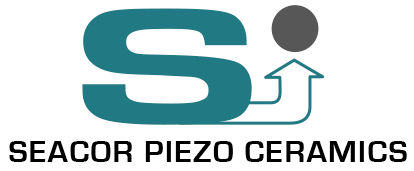Material Specification
Soft material features high sensitivity and permittivity and are well suited for static applications. They produce large displacements because their d constants are greater. However, when operated in dynamic mode, soft piezo ceramic material types suffer from high dielectric losses and high dissipation factors which may limit the ability to drive them at high frequencies.
Hard materials can withstand high levels of electrical excitation and mechanical stress. They are not easily poled or depolarised except at elevated temperature. However this stability is accompanied by smaller d constants than soft materials.
| Property | Symbol | Units | Soft Material | Hard Material | |||
| NCE51 | NCE55 | NCE81 | NCE40 | NCE41 | |||
| Dielectric Constant (1 kHz) | KT3 | 1900 | 5000 | 1020 | 1250 | 1350 | |
| Dielectric Loss Factor (1 kHz) | tanδe | 0.015 | 0.022 | 0.0017 | 0.0025 | 0.004 | |
| Dielectric Loss Factor (at 0.4V/mm) | tanδe | 0.006 | 0.0014 | 0.002 | |||
| Density | ρ | kg/m3 | 7850 | 8000 | 7730 | 7750 | 7930 |
| Curie Point | Tc | °C | 360 | 160 | 300 | 318 | 284 |
| Mechanical Quality Factor | Qm | 80 | 70 | 1400 | 700 | 1400 | |
| kp | 0.65 | 0.62 | 0.56 | 0.58 | 0.57 | ||
| k33 | 0.74 | 0.72 | 0.69 | 0.70 | 0.68 | ||
| Coupling Coefficients | |||||||
| k31 | 0.39 | 0.39 | 0.31 | 0.35 | 0.33 | ||
| kt | 0.5 | 0.5 | 0.47 | 0.50 | 0.50 | ||
| Piezoelectric Charge | d31 | Coul/N x 10-12 (or) | -208 | -260 | -100 | -140 | -13- |
| Displacement Coefficient | d33 | m/V x 10-12 | 443 | 670 | 255 | 320 | 310 |
| Piezoelectric Voltage Coefficient | g31 | -13 | -9 | -10.8 | -12 | -11 | |
| Voltage Coefficient | g33 | V·m/N x 10-3 | 26.3 | 19 | 28 | 27.5 | 25 |
| Np | 1925 | 1970 | 2300 | 2160 | 2280 | ||
| Nt | 2000 | 1990 | 2130 | 1980 | 2000 | ||
| Frequency Constants | N13 | Hz·m | |||||
| N33 | |||||||
| N31 | |||||||
| Poisson's Ratio | Y | 22 | |||||
| SE11 | 16 | 17 | 16 | 13 | 13 | ||
| SE33 | 19 | 21 | 17 | 17 | 16 | ||
| Elastic Constants Short Circuit | SE12 | x 10-12m2/N | -4.8 | -6 | -4.3 | -3.4 | -4.1 |
| SE13 | -8.9 | -7.5 | -5.4 | -5.4 | -5.7 | ||
| SE55 | 49.0 | 36.2 | 34.5 | 34.5 | 39.5 | ||
| SE66 | 43.4 | 46 | 30.8 | 31.5 | 33.2 | ||

